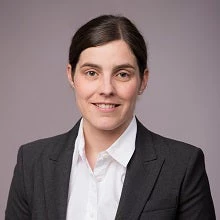 Bucharest’s deserted old town during the Covid-19 lockdown.
Bucharest’s deserted old town during the Covid-19 lockdown.
The COVID-19 pandemic resulted in the deepest global recession since World War II. As argued by Schumpeter (1942), crises can result in “creative destruction.” That is, they can play a cleansing role, by speeding up the reallocation of economic activity from less productive to more productive firms, leading to greater productivity and economic growth in the longer run. However, it is not obvious whether a pattern of creative destruction will emerge from the COVID-19 crisis. The broad-based shock may simply result in widespread destruction (here and here). Or, instead of shifting economic activity to the most productive firms, the crisis may reallocate activity to firms with greater market power or political connections, which could be detrimental to productivity growth. The question of the impact of COVID-19 on firms and its implications for long-run economic growth is thus an empirical one. How did firms fare so far?
In a new paper we examine the process of reallocation in 23 countries in Europe and Central Asia (ECA) during the COVID-19 crisis. We use data from the World Bank’s Enterprise Surveys (ES) COVID-19 Follow-up Surveys for about 8,000 firms and matched it with 2019 ES data, to study the relationship between their pre-COVID-19 labor productivity and their performance during the crisis.
Our results show that economic activity was reallocated toward more productive firms during the COVID-19 crisis. Firms with high pre-crisis labor productivity experienced smaller drops in sales and employment than firms with low pre-crisis labor productivity. More productive firms were also more likely to adapt to the crisis by increasing online activity and remote work. Our analysis indicates that the relationship between productivity and firm growth was stronger during COVID-19 than before the crisis (2017 to 2018), suggesting that creative destruction increased during COVID-19.
We also investigate how a country’s competition environment influences this process of reallocation during a crisis. When markets are competitive, they do a better job of allocating resources toward more productive firms (here, here, and here), which may be particularly relevant in a crisis. For example, in countries with a weak competition environment, market power and political connections may have more influence on which firms do better during a crisis than productivity. Weak competition can also limit firms’ innovation and ability to respond to shocks. We find that countries with a strong competition environment had more reallocation from less productive to more productive firms than countries with a weak competition environment. In countries with high competition, firms in the 10th percentile of the pre-crisis labor productivity distribution experienced an 18 percentage point larger drop in sales than firms in the 90th percentile; this difference is only 10 percentage points in countries with low competition (figure 1a). Similarly, in countries with high competition, firms in the 10th percentile of the labor productivity distribution were 15 percentage points more likely to decrease employment than firms in the 90th percentile. The corresponding differences in countries with low competition was 5 percentage points (figure 1b).
Figure 1: Firm Performance, Labor Productivity, and Competition
| |
|
| Sources: Authors’ calculations based on the most recent Enterprise Surveys COVID-19 Follow-up Surveys and Enterprise Surveys for 23 countries in Europe and Central Asia; Bertelsmann Stiftung Transformation Index (BTI) 2020. Note: Low or high market competition is defined as having a BTI market organization rating below or above the median across countries. BTI market organization is based on responses to the question: “To what level have the fundamentals of market-based competition developed?” The figure shows average values in 30 percentiles of log(labor productivity)—that is, the average y-value plotted against the average productivity in a bin/percentile range of productivity. The plots control for number of employees, firm age, gender of the top manager, innovation, state ownership, foreign ownership, access to credit or loan, ownership of a website, location of the main market (local, national, or international), sector, and country fixed effects—that is, both the y- and x-axis variables are residuals (with the mean added back in). The lines are estimated using the underlying data, not binned data. |
|
Finally, we examine what type of firms received government support during the COVID-19 crisis and assess whether the distribution of support measures may hamper competition and slow the recovery process. Many governments implemented broad support schemes to address the economic fall-out from the COVID-19 crisis. Half the firms in our sample reported receiving government support during the pandemic. The large economic shock required quick action, making it difficult for governments to target these support measures. We find that more productive firms were less likely to receive any type of government support, even controlling for the drop in sales or employment experienced by the firm. In addition, larger firms were more likely than smaller firms to receive some types of government support, which could indicate that support was more likely to go to politically connected firms. Lastly, governments provided support to firms regardless of their pre-crisis level of innovation.
As economies enter the recovery phase, it will be important for policy-makers to phase out broad policy support measures as soon as appropriate and focus on fostering a competitive business environment while continuing to protect vulnerable households. Such an environment is key to a strong recovery, resilience to future crises, and sustainable, long-term economic growth.





Join the Conversation